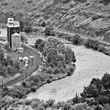If any single event was a watershed for conservation of the world's mangrove forests, it was the Indian Ocean tsunami of 2004. The day after Christmas that year, a magnitude 9.1 earthquake thundered along a fault line on the ocean floor with a force that sent waves — some a hundred feet high — surging toward the densely populated coasts encircling the Indian Ocean. The disaster took more than 225,000 lives.
In the aftermath of the tsunami, some scientists reported that settlements behind swampy, shoreline mangrove forests often suffered less damage, and fewer casualties, than areas where the forests had been cleared for aquaculture or coastal developments. Although the mangroves provided only modest protection against such a devastating tsunami, the ordeal was nevertheless a powerful reminder that mangroves can be vital buffers against storm surges, floods and the normal hazards of coastal life.
Many took the lesson to heart: Mangroves had to return.
In several affected countries, nonprofits and government agencies swiftly began planting mangrove seedlings; in Sri Lanka, plantings were made at more than 20 sites around the island’s rim. But when University of Ruhuna botanist Sunanda Kodikara visited those sites between 2012 and 2014, he was shocked to find mangroves regrowing on only about 20 percent of the area planted. Elsewhere, just a few saplings persevered, or none at all. “I saw so many dead plants,” Kodikara recalls. Especially disheartening, he says, was the fact that some $13 million had been spent on the efforts.
Such results are particularly frustrating to experts, as the need for protecting and restoring the world’s “blue forests” is greater than ever. Mangroves are mighty sponges for climate-warming gases — which makes large companies increasingly eager to pay for mangrove conservation to offset their own emissions. Mangroves are also havens for biodiversity, and living dikes that help shield against storms and waves that are growing ever stronger in a warming climate. And yet, they remain one of the world’s most threatened tropical ecosystems; we’ve lost over 35 percent of the world’s total in two recent decades, largely due to clearing of mangroves for aquaculture, agriculture, urban development and timber.
That’s why there’s rising interest from governments, nonprofits and local communities around the world in rebuilding these vital systems. But, as Kodikara saw in Sri Lanka, such endeavors often fail. In the Philippines, for instance, less than 20 percent of planted saplings survive, on average, while a large-scale study estimated a median survival rate of roughly 50 percent. Now Kodikara and other scientists are increasingly urging organizers to abandon old approaches to regrowing mangroves and the misdirected incentives that drive them. Instead, they argue for a science-based approach that takes into account the forests’ sensitive ecology and tendency to regenerate naturally, and the needs of people who live around them.
As coastal and marine ecologist Catherine Lovelock of the University of Queensland in Australia notes, “We all understand exactly how you grow a mangrove forest, and it’s been known for quite some time.” The problem, she says, has much more to do with people than with science.
Indispensable swamps
When colonial-era seafarers first encountered the stout, tangled forests that fringe the world’s tropical shorelines, they despised them for their swampy stench and dangerous inhabitants like alligators and snakes. But today, there’s a growing worldwide appreciation for these coastal jungles. Mangroves are valuable precisely because they thrive in one of the harshest environments known to trees: the intertidal zone. Salt exposure from daily inundation with seawater can cause physiological stress, and the fine-grained, waterlogged sediments the trees grow in contain little oxygen for roots to breathe.
But tens of millions of years ago, mangrove ancestors evolved ways to cope. Some species, like those in the genus Rhizophora, filter out salt and stick knobby, knee-like prop roots out of the water to breathe. Others, such as Avicennia, secrete salt through their leaves and poke snorkel-like roots above the surface.
Their complex tangle of root systems is an effective buffer against wave action, protecting coastal communities around the world against damage, notes Maria Maza, who studies coastal hydrodynamics at the University of Cantabria in Spain. A 300-meter-thick strip of mangrove reduces the height of smaller waves by more than 50 percent. And forests wider than a kilometer can reduce these waves by over 80 percent, she has found. Though their ability to protect against surges from extreme events like tsunamis and hurricanes has proved hard to measure, some studies suggest that a mangrove belt 2 to 7 kilometers thick — not unusual for undisturbed mangrove forests — can buffer storm surges that accompany hurricanes up to category 3.
Mangroves also help protect the climate by hoarding remarkable quantities of carbon. Organic matter decays extremely slowly in the oxygen-deprived soils of their intertidal habitat, so carbon from dead material remains trapped in the sediment rather than quickly escaping into the atmosphere. “It stays stable there for centuries, if not millennia,” says ecologist Martin Zimmer of the Leibniz Center for Tropical Marine Research in Germany (no relation to the author). This watery carbon reservoir, called “blue carbon,” allows mangrove ecosystems to store around four times as much carbon per unit area as tropical upland forests like some rainforests. What’s more, as organic material and sediment accumulate underneath mangrove roots, the trees gradually climb upward — helping them to keep up with rising sea levels.
There’s growing interest in protecting mangroves for the blue carbon they harbor. Mangrove restoration or conservation projects, such as an effort in Colombia funded by tech giant Apple, can sell verified carbon credits — each credit representing the equivalent of a ton of carbon dioxide stored. These are typically bought by companies to offset their greenhouse gas emissions.
Critics worry that, among other concerns, such offsets could give polluters a guilt-free reason to belch out further emissions. But in principle, restoring lost mangrove forests could benefit biodiversity, coastal communities and the climate — if it’s done right.
Planting pitfalls
Often, though, it isn’t. One common mistake is choosing planting sites that even mangroves can’t tolerate, an error Kodikara saw in Sri Lanka. Generally, mangrove forests grow only in the upper half of the intertidal zone, where they’re flooded about half the time or less. Higher than that, they can suffer stress from water-deprived, salty soils. Lower in the intertidal — which is usually where squelchy mudflats lie — the soil is often too saturated with water for the roots to source enough oxygen, explains Dominic Wodehouse, executive director of the US-based nonprofit Mangrove Action Project, which works with local communities and other groups around the world to protect and rebuild mangrove forests. And even if mangroves did manage to survive in lower intertidal areas like mudflats and seagrass meadows, they would merely replace these other, equally valuable ecosystems.
Wodehouse can show photo after photo of mangroves planted in inappropriate sites: the middle of a river, a dry, stony beach and several mudflats — including one in the Philippines where volunteers planted over a million mangrove saplings in an hour, a world record. When Wodehouse visited that site a few years later, he says, he found no trace of the activities, save for a patch of about 20,000 trees persevering near a river. To him, standing water at low tide should have been a clear warning. “What kills me is that this is an absolutely obvious failure,” he says. “It’s a complete waste of time.”
Yet mudflats remain popular planting sites among communities and governments, largely because there are few competing claims on the land. In a survey by Wodehouse and colleagues of 119 restoration projects in Thailand and the Philippines, about a third took place on mudflats, where only an average of 1.4 percent of plants survived; by contrast, he’s seen 20 to 50 percent of individuals surviving when planted in the right areas.

Another frequent misstep is planting the wrong species. Rhizophora species are darlings among planters because their seeds germinate into large, foot-long “propagules” on the trees, which can be plucked and stuck into the ground, while many other species have smaller propagules and require time in a nursery. But Rhizophora grows best in the middle zone of a mangrove forest, Wodehouse says, not on the mudflats or fringes where it’s often planted.
In 2014 and 2015, Jurgenne Primavera, chief scientific mangrove advisor with the Zoological Society of London, and her colleagues surveyed the damage on Bantayan Island after typhoon Haiyan battered the Philippine archipelago. Many Rhizophora patches along the exposed coast had suffered severe damage, with over 95 percent of trees in the oldest plantations having died off, they found. Meanwhile, species like Avicennia marina and Sonneratia alba came through relatively unscathed. Those are better adapted to the forces at the forest frontier thanks to the ability to quickly regenerate branches after they break. Primavera sees project leaders’ promises that Rhizophora will shield coastal communities as deeply misleading.
Frustrated over the failure of so many restoration projects, Zimmer, Wodehouse and Primavera recently joined ecologist Mark Huxham of Edinburgh Napier University and others in publishing a statement arguing against mass planting as a first option. As long as seed-producing trees are nearby, mangroves eagerly recolonize on their own. For instance, after mangroves on the Honduran island of Guanaja were decimated by Hurricane Mitch in 1998, ecologists observed that an area left to recover on its own regrew about as fast as nearby Rhizophora plantings.
Left to their own devices, the right species settle at the right places and densities, says Menno de Boer, technical officer at the nonprofit Wetlands International. “You get a more balanced mix of species,” he says, and this creates a more functional ecosystem. Plus, natural regeneration is “really a lot cheaper.” However, that fact doesn’t seem to be widely appreciated.
Of course, if coastal habitats are degraded, natural regrowth may not always work. In those cases, mangroves may need a little help from workers to restore the right conditions, an approach called “ecological mangrove restoration.” Along the rapidly eroding coast in Java in Indonesia some years ago, for example, Wetlands International workers built semipermeable dams to stop sediment from washing away, allowing the seafloor to rise just enough for mangroves to grow back.
And in Guinea Bissau, workers broke dikes around abandoned rice fields to restore tidal flow. Soon after, Avicennia and Rhizophora propagules from nearby forests washed into the sites and started taking. “The result was incredible,” says de Boer. “That was clearly a case where ecological mangrove restoration was much more successful and suitable than planting.”
But planting may still be better in some situations. In the Philippines, for instance, where frequent typhoons threaten to sweep away natural recruits, planting will restore mangroves faster along deforested seafronts, argues Primavera, who recently coauthored a review of the global decline of mangrove forests in the Annual Review of Environment and Resources. Another consideration, Zimmer adds, is whether to focus on restoring natural biodiversity, or what people nearby need the most: If the goal is coastal protection, it might make sense to focus on planting species that excel at that.
While there’s some room for debate, the scientific challenges around mangrove restoration are surmountable. “It’s just that we haven’t communicated it to the people who do this stuff on the ground,” Wodehouse says. “It’s frustrating to see.”
Perverse incentives
Many ecologists also blame the perverse incentives behind restoration projects. Government funds or donations often mandate planting a certain number or area of propagules within a particular time period. Under time pressure, those in charge of restoration projects often choose easily available but inappropriate sites, like mudflats. “I’m sure in many cases their intentions are totally awesome,” Lovelock says, “but then they get stuck in this problem of having to deliver a big project somehow very rapidly, and it’s just not realistic.”
In fact, some of the best areas for planting can be the hardest to secure, such as former mangrove areas converted to shrimp and fish ponds, whose owners — often difficult to identify in any case — may not want to give them up.

Once planting targets are met, organizers have often marked the project a success and moved on, leaving many subsequent failures unreported, Primavera says. Kodikara adds that there’s often no process to monitor sites after planting; it’s not uncommon to see growing saplings trampled by cattle or devoured by goats. Other times, they’re cut down for firewood by local people in need of fuel.
The solution, most experts agree, is to put the needs of local communities first and find ways to make conservation pay off for them. Community-based approaches can entail working with schools to educate children on the value of mangroves and training local people to manage their own forest’s recovery, Wodehouse says. Providing alternatives to mangrove wood — like cookstoves that use other fuels — or management plans so that communities can sustainably harvest mangrove wood can also help, de Boer adds. In one such “extractive reserve” that Zimmer has visited near the mouth of the Amazon River in Brazil, “it seems to work perfectly well,” he says, “probably because it’s managed by the people themselves.”
In principle, money from carbon credits can also provide incentive to keep mangroves growing — especially since the credits can only be issued upon verifying that the restoration effort was successful and is actually soaking up extra carbon, says Amy Schmid, who manages natural climate solutions development at Verra, a major overseer of carbon credit projects. But such models have sometimes raised concerns about “green grabbing”: Mostly rich countries appropriate land — in this case, for carbon-offset mangrove plantations — by excluding local communities from harvesting forest resources, says Marie-Christine Cormier-Salem, a social scientist with the French Institute of Research for Development.
But when communities are put at the heart of such efforts, blue carbon financing can be a win-win, as illustrated in Kenya’s Gazi Bay. Since 2013, blue carbon specialist James Kairo and others have been conserving 117 hectares of mangrove there — while supplying locals with alternative ways of making a living instead of harvesting mangroves — alongside a smaller restoration project. By selling 3,000 carbon credits annually, the project, “Mikoko Pamoja,” earns its community around $24,000 a year, which goes toward clean water, sanitation, education, health and more mangrove planting, Kairo says. “It’s a cyclic event: You’re rewarded for the effort you’re doing [so] then you have to protect the system.”
Of the four ingredients Kairo says are needed for restoration success — good science, support from government, international partnerships and buy-in from local communities — the last is the hardest to secure, but the most critical, he says. As for the blue forests themselves, they are ready to make a comeback and to help protect communities, the global climate and the countless critters that dwell in their swampy interior.
That’s on one condition, Lovelock says: “Don’t do projects in stupid places.”






























Comments